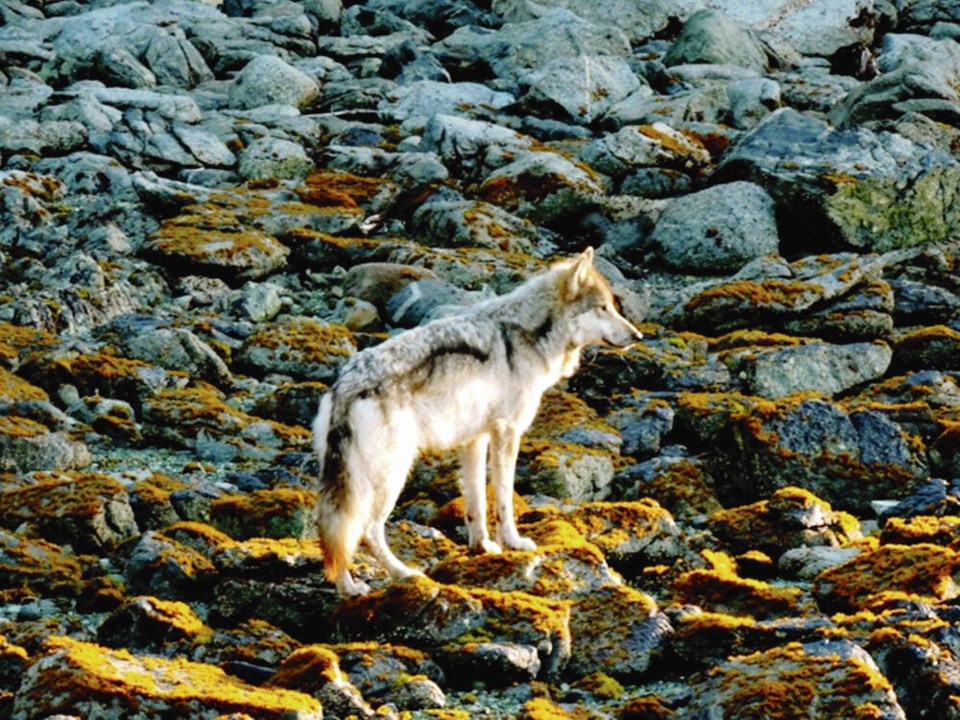The First Nations viewpoint regarding wolves, alluded to recently in these pages, is a refreshing change from all the negative portrayals of wolves in Western culture.
In an article about Parks Canada’s Wild About Wolves project, Tla-o-qui-aht First Nation Tribal Parks project co-ordinator Terry Dorward is reported as saying: “We try to keep our worlds separate from them. We try to create the space for them to flourish. It helps with keeping a healthy ecosystem intact.”
First Nations have coexisted with wolves for thousands of years. The animal is sacred and important to their cultures, with West Coast Nations honouring wolves with ceremonies and in regalia and sacred items. The animals are seen as protectors and independent beings worthy of honour and respect.
Since 2018, Parks Canada and University of British Columbia and University of Saskatchewan researchers have been working with First Nations, local communities and B.C. Parks to better understand the relationship between humans and wildlife.
As someone who was weaned on Aesop’s Fables, standard fairy tale collections, C.S. Lewis and Disney, I ingested the implied message that wolves are cruel, rapacious, vicious and even diabolical.
More mature European literature proved no more original. Wolves in Robinson Crusoe and My Antonia are not much more subtly portrayed than in Little Red Riding Hood, The Three Little Pigs, The Wolf and the Seven Little Goats and The Wolf and the Lamb.
A recent screening of Disney movies with a young friend showed that little has changed there, either. Even more recent offerings — The Secret Life of Pets 2 and Frozen — play up the “Big Bad Wolf” stereotype.
Dante, Christian church sermons, folklore and even political writings have portrayed wolves negatively for ages. The animals have long been handy whipping boys for all of our own very human insecurities and fears of wilderness, the unpredictable, the uncontrollable and the “other.”
The stereotypes have little to do with wolves and everything to do with our various suitcases of cultural baggage, but they still influence our attitudes and behaviour.
It certainly informs B.C. government policy. For example, the government has renewed a program to hunt wolves by helicopter in northeastern B.C. The effort shows the government is doing something to protect the region’s endangered caribou herds, despite wildlife ecologists and other researchers disputing it will help when logging of the area’s little remaining old-growth caribou habitat continues.
On 91原创 Island, a hunter can bag three wolves, but the system relies on self-reporting. No limit exists on wolf trapping.
We saw that when Takaya, the lone wolf that had lived for eight years on Discovery Island, off Oak Bay, was shot in 2020 near Shawnigan Lake.
A similar story unfolded last year in Sooke, when an Island-based trophy hunter posted photos on Facebook of what appeared to be two dead wolves from a pack that had made the Sooke area its home. She wrote she had “caught wind of a problem wolf pack that was snatching people’s cats and dogs.”
She went on to say she had dusted off the traps, set them out and one of the wolves had come in. “Full pack removal is always the goal, so now we adjust and reset.”
This shows that research into the animals and outreach with communities living in wolf territories are all the more important.
The reintroduction of wolves into Yellowstone Park in 1995 has provided many insights into the animals’ key roles in supporting and maintaining ecosystems. After wolves became re-established there, the area’s forest and river health improved, the amount of disease in the local deer and elk populations dropped, and endangered species that had struggled in the area started thriving.
The work that Parks Canada and its partners are undertaking in B.C. explores wolf ecology, traditional ecological knowledge, and people’s values, attitudes and beliefs about wolves and human-wolf interactions, with the goal of reducing human-wolf conflicts in national parks and elsewhere.
Indeed, the vast majority of so-called wildlife problems are actually problems that people have created through their own attitudes and behaviours.



